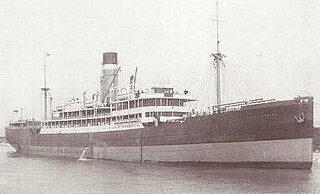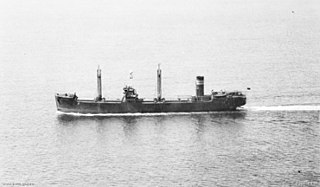
HMT Rohna was a British India Steam Navigation Company passenger and cargo liner that was built on Tyneside in 1926 as SS Rohna and requisitioned as a troop ship in 1940. Rohna was sunk in the Mediterranean in November 1943 by a Henschel Hs 293 guided glide bomb launched by a Luftwaffe aircraft. More than 1,100 people were killed, most of whom were US troops.

SS Ceramic was a steam ocean liner built in Belfast for White Star Line in 1912–13 and operated on the Liverpool – Australia route. Ceramic was the largest ship serving the route until P&O introduced RMS Mooltan in 1923.
SS Cambridge was a refrigerated steam cargo liner that was built in Germany for the Hamburg America Line. She was launched in 1916 as Vogtland, but after the 1919 Treaty of Versailles the United Kingdom took her as war reparations and sold her to the Federal Steam Navigation Company, who renamed her Cambridge. She operated between Britain and Australasia until 1940, when a German mine sank her off the coast of Australia.

SS City of Venice was an intermediate ocean liner that was launched in 1924 in Northern Ireland for Ellerman Lines. In the Second World War she was a troop ship. In 1943 a U-boat sank her in the Mediterranean, killing 22 of the crew and troops aboard.

SS Clan Fraser was a British cargo steamship. She served in the Second World War and was bombed and sunk in Greece in 1941.

SS Iron Knight was a bulk carrier that was built in Scotland in 1937 for the Australian Broken Hill Pty, Ltd (BHP) to carry iron ore. A Japanese submarine sank her by torpedo off the coast of New South Wales in 1943, killing 36 of her crew. A wreck that was identified as that of Iron Knight is protected by the Australian federal Underwater Cultural Heritage Act 2018.
SS Manistee was an Elders & Fyffes Ltd banana boat that was launched in 1920. She was one of a numerous class of similar banana boats built for Elders & Fyffes in the 1920s.
HMS Hilary was a Booth Line passenger steamship that was built in Scotland in 1908 and operated scheduled services between Liverpool and Brazil until 1914. In the First World War she was an armed merchant cruiser (AMC) until a u-boat sank her in the Atlantic Ocean in 1917.
MV British Prudence was a tanker built by Sir James Laing & Sons Ltd. of Sunderland in 1939 and operated by the British Tanker Company. A U-boat sank her in 1942 off the coast of Newfoundland. She was a victim of the Second Happy Time: the Kriegsmarine's Operation Paukenschlag to sink Allied merchant shipping in the Western Atlantic
MV El Argentino was a refrigerated cargo motor ship that was built in Scotland in 1920 and sunk by a German aircraft in the Atlantic Ocean in 1943.

Empire Dabchick was a 5,995 GRT Design 1019 cargo ship that was built in 1919 as Kisnop by Atlantic Corporation, Portsmouth, New Hampshire, United States for the United States Shipping Board (USSB). She was transferred to the United States Maritime Commission (USMC) in 1937. In 1940 she was transferred to the Ministry of War Transport (MoWT) and renamed Empire Dabchick. She served until December 1942, when she was torpedoed and sunk by German submarine U-183.
MV Abosso was a passenger, mail, and cargo liner, the flagship of Elder Dempster Lines. In peacetime she ran scheduled services between Liverpool and West Africa. In the Second World War she was a troop ship, running between the United Kingdom, West Africa, and South Africa.
SS Clan Macarthur was a British refrigerated cargo steamship. She was built for Cayzer, Irvine and Company's Clan Line Steamers Ltd as one of its Cameron-class steamships. She was launched in Greenock in 1936 and sunk in the Indian Ocean by enemy action in August 1943.
SS Llanashe was a UK cargo steamship. She was launched in 1936 in Sunderland, England, and sunk by a U-boat in the Indian Ocean in February 1943.
SS Nailsea Court was a UK cargo steamship. She was launched in 1936 in Sunderland, England. She was named after Nailsea Court in Somerset, England, which is an historic Elizabethan manor house. A U-boat sank her in the North Atlantic in March 1943. 45 men died and only four survived.
MV Seaforth was an Elder Dempster Lines cargo motor ship that traded between Liverpool and West Africa. She was launched in 1938 in Scotland and sunk in 1941 in the North Atlantic.
MV Henry Stanley was a UK cargo motor ship that traded between Liverpool and West Africa. She was launched in 1929 in Scotland and sunk in 1942 in the North Atlantic.
SS Huntingdon was a refrigerated steam cargo liner that was built in Germany in 1920 as Münsterland. The United Kingdom took her as war reparations and sold her to the Federal Steam Navigation Company, who renamed her Huntingdon. She operated between Britain and Australasia until 1941, when an Italian submarine sank her in the Atlantic Ocean.
SS Blitar was a Dutch cargo steamship that was launched in Rotterdam in 1922 and sunk in the Battle of the Atlantic in 1943. She is notable for having fought off three u-boats in succession for nearly ten hours before U-632 finally managed to sink her. 26 of Blitar's complement were killed.
HMS Malvernian was an Ellerman Lines cargo steamship that was built in 1937. In January 1941 she was converted into an ocean boarding vessel. That July she sank after a German air attack crippled her in the Atlantic Ocean.





